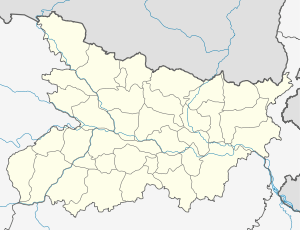Patna Museum
|
| |
 Patna Museum | |
| Established | 1917 |
|---|---|
| Location | Buddha Marg, Patna, Bihar |
| Coordinates | 25°36′40″N 85°8′38″E / 25.61111°N 85.14389°E |
| Type | Archaeological & Natural[1] |
| Visitors | 800,119 (2007) |
| Director | JPN Singh[2] |
Patna Museum is the state museum of the Indian state of Bihar. Built in 1917 during the British Raj to house the historical artefacts found in the vicinity of Patna,[3] it is in the style of Mughal and Rajput architecture and is known locally as the Jadu Ghar.
History
The Museum was constructed by the British to conserve and display the historical artifacts found in the vicinity of the state capital. The concept of having a museum arose in 1912, after Bihar and Bengal were separated. Patna Museum started functioning in 1915 from the commissioner's bungalow, on the campus of A. N. Sinha Institute.
The artifacts were then shifted to new rooms at the Patna High Court building before being taken to the present building in 1929. The land that was selected for the museum, in 1925, was on Patna-Gaya road (now Budh Marg). The two-storeyed building, designed by Rai Bahadur Bishnu Swarup, was completed in 1928.[4] It was opened as the first museum of Bihar and Orissa Province by then Governor of Bihar and Orissa, Sir Hugh Lansdown Stephenson.[4]
Collections

Items on display in the multipurpose museum include archaeological objects, coins, art objects, paintings, instruments, textiles, paintings, thankas, bronze images and sculptures and terra cotta images by Hindu and Buddhist artists.[1] It has a rare collection of British-period paintings depicting day-to-day life, as well as a fine collection related to the first President of India, Rajendra Prasad. It also houses a World War I cannon.[5]
The fossil of a tree said to be more than 200 million years old is on display,[1] as is a casket — unearthed in 1958 by archaeologist, A. S. Altekar, at the Relic Stupa of Vaishali — said to contain the sacred ashes (relics) of Gautama Buddha.[6] A Didarganj Yakshi statue, discovered on a Ganges riverbank in 1917, is the museum's most prized collection.[1]
Beginning November 2009, a project was started to build a replacement museum in Patna to enable the display of larger collections.
Gallery
.jpg) Brick Sculpture of Buddha
Brick Sculpture of Buddha.jpg) 'Dwar Stambh', Udyagiri, 8th Century AD
'Dwar Stambh', Udyagiri, 8th Century AD.jpg) Buddha, Gaya, 10th Century
Buddha, Gaya, 10th Century.jpg) Samvara, Ratnagir, 10th Century
Samvara, Ratnagir, 10th Century.jpg) Tara, Gaya, 10th-11th Century
Tara, Gaya, 10th-11th Century
See also
References
- 1 2 3 4 "Patna Museum". patna.bih.nic.in. Archived from the original on December 29, 2006. Retrieved July 23, 2016.
- ↑ "Museum fun plan to woo kids". Telegraphindia.com. 2014-02-10. Retrieved 2014-03-06.
- ↑ "Archived copy". Archived from the original on May 9, 2008. Retrieved November 29, 2008.
- 1 2 Abhay Kumar, Patna, Dec 21, 2013: (2013-12-21). "Museum artefacts find place in Belgium festival". Deccanherald.com. Retrieved 2014-03-06.
- ↑ "Destinations :: Patna ::Bihar State Tourism Development Corporation". Bstdc.bih.nic.in. Retrieved July 23, 2016.
- ↑ Pranava K. Chaudhary, "Holy ashes fail to attract pilgrims" in Times of India, March 1, 2003.
| Wikimedia Commons has media related to Patna Museum. |